GRAFTING ON OPUNTIA COMPRESSA
(based on articles of Valentino Vallicelli, Cactus Art Nursery)
Irina Ten, USA
Cactus Art Nursery was started three years ago by cactus enthusiast Valentino Vallicelli (Italy). On his web site he tells about his experience with Opuntia compressa as a grafting stock.
Opuntia compressa is a very healthy, frost- and wet-resistant species. It is a long lasting, nearly invisible stock suited for all small globular cacti and also useful for monstrose and crested forms. All frost-resistant North American species (Pediocactus, Sclerocactus, Toumeya) and also hardy South American and delicate Andean species do the best when grafted on this stock.

| 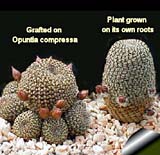
| 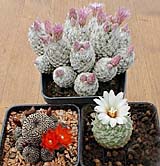
|
Photo 7.
Photo 8.
| Photo 9.
| | |
Cacti grafted on Prickly Pear don't grow as quickly as on the commonly used stocks like Hylocereus and Myrtillocactus, but the plants have very natural appearance and size. Cacti grafted on Prickly Pear, even very young plants, bloom earlier and produce greater number of flowers in comparison to those on other stocks. Compare the photo of a very young Mammillaria sanchez-mejorade (left photo) and the photo of a three-year old specimen grafted on Trichocereus, bigger but bearing only a few flowers.
During winter months the stocks dehydrate a lot. This water reduction confers frost hardiness to the plants. All grafted plants are kept in a non-heated greenhouse and doing very well.
In a few years the stock hides under the scion, disappearing completely, so you can grow your slow growing and delicate cactus as an ordinary non-grafted plant.
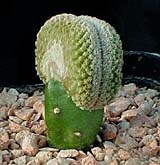
| 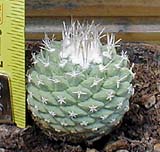
| 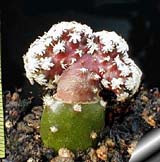
|
Photo 10. Strombocactus disciformis cristatus
Photo 11. Strombocactus disciformis
| Photo 12. Mammillaria theresae crested
| | |
Advantages of grafting on Opuntia compressa
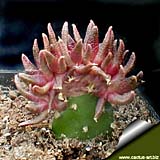 |
| Photo 13. Ariocarpus scapharostrus polytomic crest
|
Grafting on Opuntia is very long lasting in comparison to the grafting made on other stocks. One of the main problems with grafted plants is the formation of a woody neck at the joint between scion and stock. For example, the graftings made on Hylocereus grow very fast in the first or second year, but soon the connection point between the two plants became suberose and further growth is seriously reduced. It is better to detach the scion and reroot or regraft it on another young stock.
On Photo 3 you can see two Ariocarpus grafted when they were very young seedlings (only few days old) on two different stocks: the first on a young Opuntia seedling and the second on a few days Cereus peruvianus. The Opuntia grows and enlarges as the scion enlarges, the attachment is perfect and almost invisible, no woody neck is formed and after three years there are no signs of suberization, an uniform layer of elastic epidermis has been formed and the plants keep growing healthy and strong. Initial excellent performance of the plant grafted on Cereus peruvianus has been nullified.
 |
| Photo 14. Mammillaria luethyi
|
Spectacular and abundant blossom on very young plants. The plants shown on Photo 4 (Mammillaria theresae & Rebutia heliosa) are not yet one-year old, but they are already blooming. This is very appreciable characteristic for those who loves flowers and for anybody who wishes to get fruits and seeds quickly.
New roots are easily produced at the scion base. The production of new roots at the scion base is very important. After a few years, as soon as the plants reach good size, it is possible to root the scion while it is still grafted. It is possible to bury and hide the stock deeply in the ground, so it becomes invisible and the scion starts developing its own new roots and, at the same time, it is still fed and supported by the stock. If the stock is too large you can cut it at 1-2 cm below the joint, and root it like a common cutting.
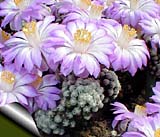 |
| Photo 15. Mammillaria theresae blooming
|
Strong and healthy root apparatus. Opuntia is a robust stock, it does not mind at all if the soil is too wet.
Grafted plants grow compact and form clusters of offsets quickly. The plants grafted on Opuntia grow flat and compact, they don't elongate so much like the plants on their own roots. Moreover, they branch very precociously and form clusters quickly. Some cultivars, like Astrophytum 'Superkabuto', grow very flat (but don't branch) and it is possible to obtain very nice specimens.
However plants on Opuntia have a very natural look. The plants in the picture are three years old (at the beginning of the fourth spring of their life), they were grafted as very young seedlings on Opuntia hypocotile, now the stock is invisible.
Strombocactus disciformis, Rebutia heliosa and Escobaria leei are very pleasant in appearance, bloom profusely, they are well-developed and healthy but not deformed like many of the common grafts usually seen.





